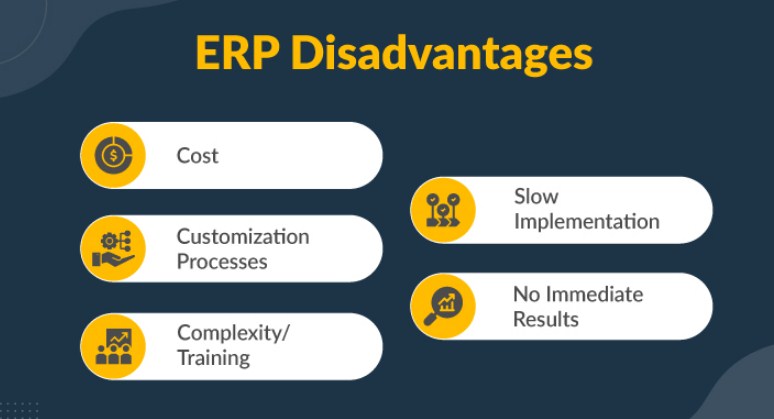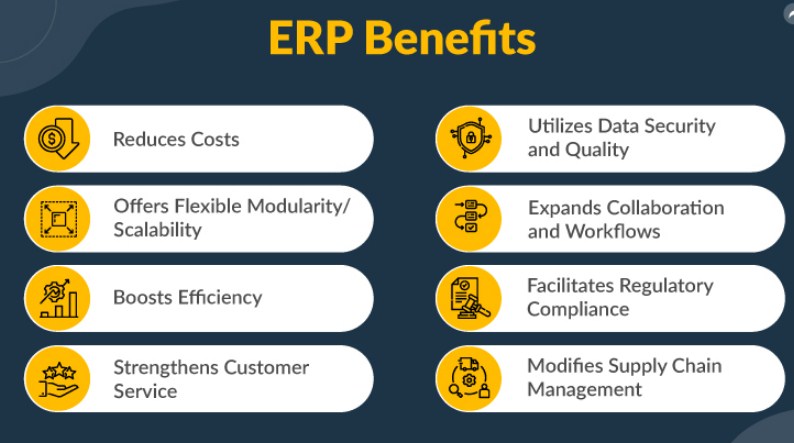Disadvantages of ERP Systems – Enterprise Resource Planning (ERP) systems are essential tools that streamline and integrate various business processes, from finance and human resources to inventory and supply chain management. However, like any technology, ERP systems are not without their drawbacks. In this article, we’ll explore the disadvantages of ERP systems, the challenges businesses face when implementing them, and solutions to mitigate those risks.

What is an ERP System?
An ERP (Enterprise Resource Planning) system is a suite of integrated software applications used by organizations to manage day-to-day business activities such as accounting, procurement, project management, risk management, and supply chain operations. These systems help companies streamline processes and information across all departments, providing a unified platform to improve productivity and decision-making.
Why Are ERP Systems Important?
ERP systems enable better data flow and reduce redundancies, resulting in more accurate and timely decision-making. However, businesses must be aware of their potential downsides when considering ERP implementation.
Key Disadvantages of ERP Systems
While ERP systems offer numerous advantages, there are some disadvantages that businesses should consider before committing to a solution. Let’s explore the top challenges:
1. High Implementation Costs
Implementing an ERP system can be extremely expensive. This includes software costs, hardware requirements, customization, consulting fees, and employee training. Small to medium-sized businesses (SMBs) may struggle to absorb these costs, making the ERP implementation process an intimidating investment.
Example: A company may spend upwards of $500,000 or more for a comprehensive ERP system setup. If not planned carefully, this investment might not yield a return in the short term.
2. Time-Consuming Implementation
Implementing an ERP system is rarely a quick process. Depending on the complexity of the system, the integration of various modules, and the number of departments involved, ERP implementation can take months or even years to fully execute. This can disrupt regular business operations, causing frustration among employees and delays in achieving the expected benefits.
Solution: Choose ERP solutions with a clear and structured implementation timeline, and ensure you have the necessary resources to complete the project on time.
3. Complexity of Use
Some ERP systems can be overly complex, requiring significant training for employees to understand how to use them effectively. For companies with a non-tech-savvy workforce, this can be a serious hindrance to the successful adoption of the system.
Solution: Choose ERP solutions that are intuitive and user-friendly, or consider offering ongoing training and support.
4. Resistance to Change
Employees are often resistant to change, especially when they are required to transition from legacy systems to a new ERP system. This resistance can slow down the implementation process and hinder the overall success of the ERP system.
Solution: Involve employees in the ERP decision-making process early on, and provide adequate support and incentives to ease the transition.
5. Customization Challenges
ERP systems may require extensive customization to meet the specific needs of a business. This can lead to increased costs, complexity, and longer implementation times. Additionally, excessive customization can lead to issues with system updates and maintenance.
Solution: Choose ERP systems that offer a balance of flexibility and standardization to minimize the need for extensive customization.
Real-World Examples of ERP Products
Below are five real-world ERP products, their features, pros and cons, and how they handle the disadvantages discussed above.

Example 1: SAP ERP
SAP is one of the most widely used ERP systems globally, serving industries ranging from manufacturing to finance.
| Feature | SAP ERP |
|---|---|
| Use Case | Large enterprises needing complex functionalities |
| Pros | Highly customizable, scalable, integrates well |
| Cons | High cost, steep learning curve, long implementation time |
| Price | Custom pricing based on business needs |
| Key Features | Financials, logistics, HR, supply chain management |
Why It’s Beneficial: SAP ERP is best suited for large organizations with complex needs. The system’s scalability makes it ideal for multinational corporations, but its high cost can be prohibitive for smaller businesses.
Example 2: Microsoft Dynamics 365
Microsoft Dynamics 365 offers a suite of integrated applications for finance, operations, sales, and customer service.
| Feature | Microsoft Dynamics 365 |
|---|---|
| Use Case | Businesses looking for a comprehensive solution with strong customer relationship management |
| Pros | Seamless integration with Microsoft products, cloud-based, user-friendly |
| Cons | Limited customization, high subscription costs |
| Price | Starting at $50 per user/month |
| Key Features | Sales automation, financial management, CRM |
Why It’s Beneficial: Dynamics 365’s cloud-based solutions are ideal for companies already using Microsoft tools. Its ease of integration with existing software makes it a top choice for companies transitioning from legacy systems.
Example 3: Oracle ERP Cloud
Oracle ERP Cloud is a comprehensive cloud-based solution for finance, procurement, and project management.
| Feature | Oracle ERP Cloud |
|---|---|
| Use Case | Large enterprises, global operations |
| Pros | Advanced analytics, AI-powered, scalable |
| Cons | Expensive, complex setup |
| Price | Custom pricing based on business needs |
| Key Features | Financial management, supply chain, analytics |
Why It’s Beneficial: Oracle ERP Cloud is ideal for businesses looking to leverage advanced technologies like artificial intelligence (AI) and machine learning. Its extensive feature set is perfect for large enterprises with complex needs.
Example 4: NetSuite ERP
NetSuite ERP is a cloud-based solution designed to streamline business operations, from finance to inventory management.
| Feature | NetSuite ERP |
|---|---|
| Use Case | Small to medium businesses with high growth potential |
| Pros | Cloud-based, easy to implement, real-time reporting |
| Cons | Can become costly as the business grows |
| Price | Starting at $999 per month |
| Key Features | Financials, CRM, eCommerce integration |
Why It’s Beneficial: NetSuite is designed to help growing companies manage their finances and operations with a scalable, user-friendly platform. It’s an excellent option for small to medium-sized businesses.
Example 5: Odoo ERP
Odoo is an open-source ERP system known for its modular approach.
| Feature | Odoo ERP |
|---|---|
| Use Case | Small businesses seeking flexibility |
| Pros | Open-source, affordable, highly customizable |
| Cons | Lacks some advanced features, support challenges |
| Price | Free for basic version, pricing starts at $20 per user/month |
| Key Features | Accounting, inventory, project management, HR |
Why It’s Beneficial: Odoo ERP is cost-effective and allows businesses to choose the modules they need. It’s perfect for small businesses or startups that want an affordable solution with flexibility.
How to Overcome ERP System Challenges
Here are some practical ways to mitigate the disadvantages of ERP systems:
1. Focus on Employee Training
One of the key reasons ERP implementations fail is lack of adequate training. Invest in comprehensive training programs for your employees to ensure they are comfortable using the system.
2. Choose the Right ERP for Your Business
Before selecting an ERP system, evaluate your business needs carefully. Choose a system that fits your requirements and can scale as your company grows.
3. Work with Experienced Consultants
Hiring experienced consultants or ERP vendors can help smooth the implementation process and ensure that the system meets your expectations.
Where to Buy ERP Systems & Pricing Information
- SAP ERP: Purchase directly through SAP’s website.
- Microsoft Dynamics 365: Available for purchase at Microsoft Dynamics 365.
- Oracle ERP Cloud: Visit Oracle’s ERP page for pricing.
- NetSuite ERP: Purchase via NetSuite.
- Odoo ERP: Get started on Odoo’s website.
FAQs
1. What is the main disadvantage of ERP systems?
The most significant disadvantage is the high cost of implementation, especially for small to medium-sized businesses.
2. Can ERP systems be customized?
Yes, most ERP systems allow for extensive customization to suit specific business needs, although this can increase costs and complexity.
3. How long does it take to implement an ERP system?
Implementation time can range from a few months to over a year, depending on the complexity and size of the organization.
4. Are ERP systems difficult to use?
ERP systems can be complex, but many modern systems are designed with user-friendly interfaces. Training is key to success.
5. Is ERP suitable for small businesses?
Yes, there are ERP solutions specifically designed for small businesses, such as Odoo and NetSuite.
Conclusion: While ERP systems can be transformative, businesses need to weigh the advantages against the disadvantages before making a decision. Proper planning, training, and choosing the right solution can help minimize the challenges associated with ERP implementation.
Read More >>>
- Discover the Key Components of ERP Systems: Benefits, Features & Buying Guide
- Best ERP for Manufacturing: A Comprehensive Guide to Streamline Your Operations